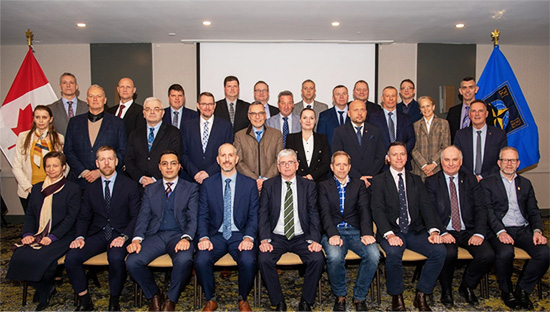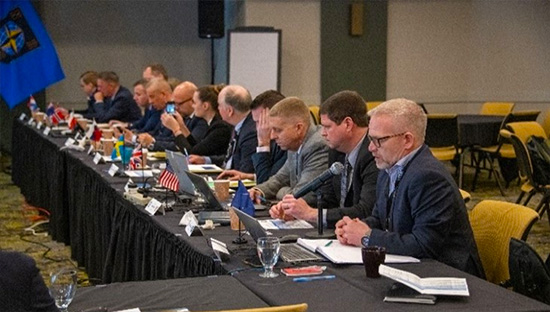Canada hosts NATO to discuss Reserve Force Capabilities
April 30, 2024 - Defence Stories
Author: Captain Jonathan Link, Chief of Reserves

Caption
NATO NRFC staff officer representatives meet in Toronto to exchange information and sharing of best practices about the Reserve Forces of their nation.
Photo Credits: MS Callum Rutherford, 4 Cdn Div JTFC HQ, Canadian Armed Forces Photo.
Over 30 international NATO National Reserve Forces Committee (NRFC) Staff Officers met in Toronto in March 2024 to discuss best practices regarding their Reserve Forces. This meeting was the first with representation from Sweden as NATO’s newest member. In addition to NATO members, Canada welcomed staff officers from a number of close international partners from Europe and the Indo-Pacific.
Colonel Kim Pedersen from Denmark, NRFC Secretary General, stressed “the Committee is an important forum for knowledge sharing between member states and partner nations – ways to implement best practices on Reserve matters are presented and discussed, including how to enable full-time capability though part-time service.”
“In the past decade, the significance of reservists within national armed forces has increased,” Colonel Pedersen, a reservist himself, noted. “With reservists comprising a significant portion of national forces in some NATO countries, it is helpful to discuss the diverse national approaches to both generating and employing Reserve Forces”.
"In the past decade, the significance of reservists within national armed forces has increased,” Colonel Pedersen, a reservist himself, noted. “With reservists comprising a significant portion of national forces in some NATO countries, it is helpful to discuss the diverse national approaches to both generating and employing Reserve Forces”.
Colonel Kim Pedersen
Adding capacity to the Regular Forces through individual augmentation from the Reserve Forces has been the priority in Canada and most other NATO countries. While this focus has not gone away, adding capabilities is now recognized as one means to address certain skills shortages created by civilian workforce demands (and salaries). Hiring Reservists with these expert skills not only maintains these militaries capabilities, it keeps them current as they upgrade their skills in their civilian occupation.
“[Reservists] bring invaluable expertise in areas such as drones, information technology, cyber, logistics, human resources, finance, and medical,” said Colonel Pedersen, “… and given the salaries these trades can command in the civilian world, offering part-time service in these fields maybe he only way to enroll these folks”.

Caption
12 participants of the NRFC staff officers meeting seated at a table take notes and engage in discussions.
Photo Credits: MS Callum Rutherford, 4 Cdn Div JTFC HQ, Canadian Armed Forces Photo.
Canadian Commander David Mercer presented A New Vision for the Reserve Force for Canada. “This is what [Canada’s] New Vision document addresses; we are building full-time capability through part-time service,” said Canadian Brigadier General Shawn Bindon, Director General Reserve Force Strategic Initiatives, “It’s a plan to project and employ the Reserve Force to support Force Posture and Readiness. It’s also a plan to address what the individual modern reservist needs and make sure we are offering it.”
“Some of the member states can recruit a significant percentage of the population and provide the initial military training,” said Colonel Pedersen, “… but there is a general lack of manpower for the military in most nations so any inspiration on how to attract and retain soldiers is highly relevant.”
Given the current situation on some of NATO’s borders, the next question is: How fast can any nation build and mobilize their Reserves in an emergency? How NATO nations address these matters was the subject of several of the presentations at the NFRC meeting.